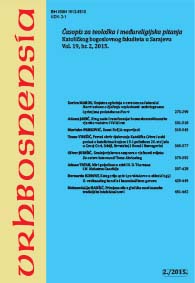Pravni okvir djelovanja Katoličke Crkve i neki podaci o katolicima krajem 19. i početkom 20. stoljeća u Crnoj Gori, Srbiji, Hrvatskoj i Bosni i Hercegovini
Legal Framework for Activity of the Catholic Church in Montenegro, Serbia, Croatia and Bosnia and Herzegovina in the late 19th and early 20th Century and Some Data about Catholics there
Author(s): Tomo VukšićSubject(s): History of Church(es), Social history, 19th Century, Pre-WW I & WW I (1900 -1919), Between Berlin Congress and WW I
Published by: Katolički bogoslovni fakultet
Keywords: the position of the Church; concordats; Montenegro; Serbia; Croatia; Bosnia and Herzegovina; the number of Catholics and number of other believers; the church organization;
Summary/Abstract: The condition of the Catholic Church in the early 20th century on the territory of today's Montenegro, Serbia, Croatia, and Bosnia and Herzegovina was extremely complex and very different from the situation today. This article analyzes church circumstances at that time examining demographic facts regarding Catholics, church organization, and legal regulation of relations between Church and state at the time. Catholics lived as a small community in Montenegro and Serbia. Their situation in Montenegro was governed by a contract between the state and the Holy See (1878) and they had an archdiocese with headquarter in the city of Bar. On the other side, the legal status of the Catholic Church in Serbia, where there was no diocese, was not resolved until 1914, when a concordat with the Holy See was signed. However, this concordat was not implemented due to the outbreak of the First World War. In the region of today's Croatia, Catholics were a majority almost everywhere. The legal status of the Church, which was organized in three major metropolitan districts (Zagreb, Zadar, Gorica), was arranged firstly through a concordat between the Holy See and Austria-Hungary in 1855, and later under special laws enacted in 1874. In order to regulate the position of the Catholic Church in Bosnia and Herzegovina, where Catholics represented about 18 percent of the population, the Austro- Hungarians in 1881, before the establishment of new dioceses and the appointment of new bishops, signed a special agreement with the Holy See. All of these agreements with the Holy See, except the one of 1855, which ceased to be valid after 1870, signed by individual countries and implemented at the beginning of the 20th century are presented here in the original language and in translation.
Journal: Vrhbosnensia
- Issue Year: 2015
- Issue No: 2
- Page Range: 345-377
- Page Count: 33
- Language: Croatian

